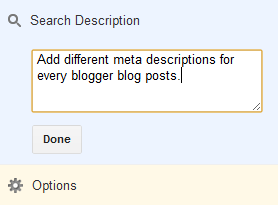“Great ability develops and reveals itself increasingly with every new assignment.”
It's all about Computer Science.
“Great ability develops and reveals itself increasingly with every new assignment.”
<title><data:blog.pageTitle/></title>
<b:if cond=’data:blog.pageType == "item"’>
<title><data:blog.pageName/> | <data:blog.title/></title>
<b:else/>
<title><data:blog.pageTitle/></title>
</b:if>
<h3><data:title/></h3>
<h2><data:title/></h2>

<b:if cond=’data:blog.metaDescription != ""’>
<meta expr:content=’data:blog.metaDescription’ name=’description’/>
</b:if>
User-agent: Mediapartners-Google
Disallow:
User-agent: *
Disallow: /search/
Disallow: /search?
Disallow: /search?q=*
Disallow: /*?updated-max=*
Disallow: /p/about.html
Disallow: /p/privacy.html
Allow: /
Sitemap: http://www.9to5blogger.com/atom.xml?redirect=false&start-index=1&max-results=500
<a expr:href=’data:label.url’ rel=’tag’>Either add the nofollow tag to the end of the above syntax or simply replace it with the below one.
<a expr:href=’data:label.url’ rel=’tag,nofollow’>Save your template.

- utm_source > No > Let Googlebot decide
- utm_medium > No > Let Googlebot decide
- utm_campaign > No > Let Googlebot decide
- updated-max > Yes > Sorts > Let Googlebot decide
- showComment > No > Let Google bot decide
- max-results > Yes > Sorts > Let Google bot decide
- m > Yes > Paginates > Let Google bot decide
- commentPage > Yes > Paginates > Every URL

#include<iostream>
using namespace std;
int main()
{
// Variable Declaration
int counter, num, fact = 1;
// Get Input
cout<<"Enter the Number to find its Factorial: ";
cin>>num;
//'for' Loop
for (int counter = num; counter >= 1; counter--)
{
fact = fact * counter;
}
cout<<endl;
cout<<"Factorial of "<<num<<" is: "<<fact<<endl;
return 0;
}
On December 10, 1815 (the same year that George Boole was born), a daughter Augusta Ada ByronÑ was born to Anna Isabella (Annabella) Byron and George Gordon, Lord Byron. At that time in England Byron’s fame derived not only from his poetry but also from his wild and scandalous behavior. The marriage was strained from the beginning, and Annabella left Byron
shortly after Ada’s birth. By April of 1816, the two had signed separation papers. Byron left England, never to return. Throughout the rest of his life he regretted that he was unable to see his daughter. At one point he wrote of her,
I see thee not. I hear thee not.
But none can be so wrapt in thee.
Before he died in Greece, at age 36, he exclaimed,
Oh my poor dear child! My dear Ada!
My God, could I but have seen her!
Meanwhile, Annabella, who eventually was to become a baroness in her own right, and who was educated as both a mathematician and a poet, carried on with Ada’s upbringing and education. Annabella gave Ada her first instruction in mathematics, but it soon became clear that Ada was gifted in the subject and should receive more extensive tutoring. Ada received further training from Augustus DeMorgan, today famous for one of the basic theorems of Boolean algebra. By age eight, Ada had demonstrated an interest in mechanical devices and was building detailed model boats.
When she was 18, Ada visited the Mechanics Institute to hear Dr. Dionysius Lardner’s lectures on the “Difference Engine”, a mechanical calculating machine being built by Charles Babbage. She became so interested in the device that she arranged to be introduced to Babbage. It was said that, upon seeing Babbage’s machine, Ada was the only person in the room to understand immediately how it worked and to recognize its significance. Ada and Charles Babbage became lifelong friends. She worked with him, helping to document his designs, translating writings
about his work, and developing programs for his machines. In fact, Ada today is recognized as the first computer programmer in history.
When Babbage designed his Analytical Engine, Ada foresaw that it could go beyond arithmetic computations and become a general manipulator of symbols, and thus would have far-reaching capabilities. She even suggested that such a device eventually could be programmed with rules of harmony and composition so that it could be produce “scientific” music. In effect, Ada foresaw the field of artificial intelligence more than 150 years ago.
In 1842, Babbage gave a series of lectures in Turin, Italy, on his Analytical Engine. One of the attendees was Luigi Menabrea, who was so impressed that he wrote an account of Babbage’s lectures. At age 27, Ada decided to translate the account into English, with the intent to add a few of her own notes about the machine. In the end, her notes were twice as long as the original material, and the document, “The Sketch of the Analytical Engine,” became the definitive work on the subject.
It is obvious from Ada’s letters that her “notes” were entirely her own and that Babbage was acting as a sometimes unappreciated editor. At one point, Ada wrote to him,
I am much annoyed at your having altered my Note. You know I am always
willing to make any required alterations myself, but that I cannot endure
another person to meddle with my sentences.
Ada gained the title Countess of Lovelace when she married Lord William Lovelace. The couple had three children, whose upbringing was left to Ada’s mother while Ada pursued her work in mathematics. Her husband was supportive of her work, but for a woman of that day such behavior was considered almost as scandalous as some of her father’s exploits.
Ada died in 1852, just one year before a working Difference Engine was built in Sweden from one of Babbage’s designs. Like her father, Ada lived only to age 36, and even though they led very different lives, she undoubtedly admired him and took inspiration from his unconventional and rebellious nature. In the end, Ada asked to be buried beside him at the family’s estate.

